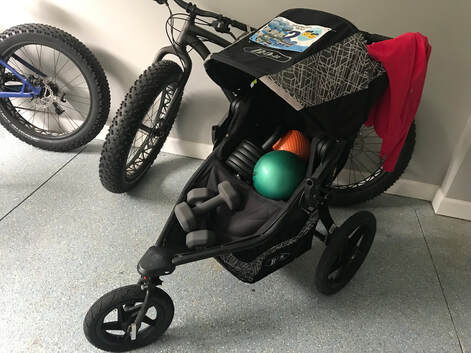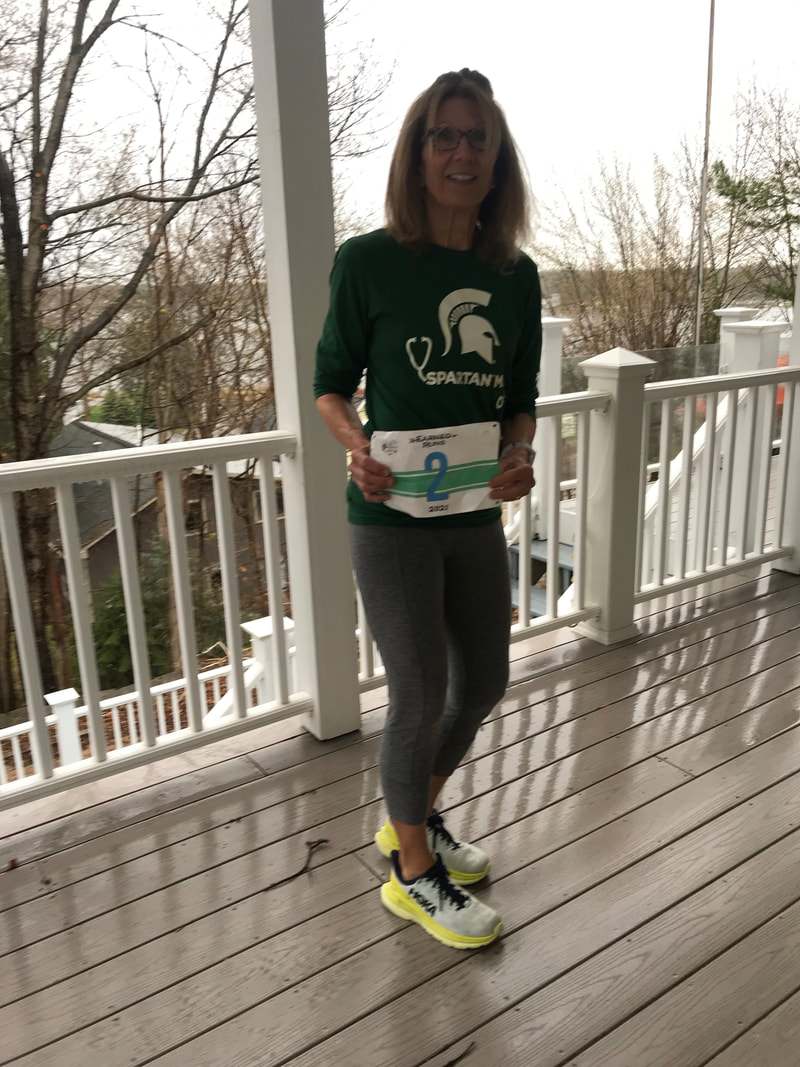BLOG
|
|
MOBILE "GYM" ALLOWS STRENGTH AND HIGHER INTENSITY CARDIO-RESPIRATORY FITNESS TRAINING. WHEN I SWITCHED FROM MOSTLY RUNNING FOR EXERCISE to fitness walking, I was recovering from a knee injury. The revelation that osteoarthritis was the underlying reason for the problem caused me to reconsider my fitness routine. It no longer seemed wise to pound the pavement daily and neglect other forms of exercise.
Strength training officially became more important, once it was prescribed by my orthopedic surgeon to help limit further knee damage. I knew it would extend the natural life of all joints and work to build bone. But it would not serve as a fun form of aerobic fitness training. At that time I started investigating alternate forms of cardio-respiratory exercise like cycling, swimming, rowing, and elliptical work. If I could no longer rely on putting in hours of running each week to benefit cardiovascular health, other endurance training would be needed to fill the gap. However, most of these other exercise modes were low impact and not the best for maintaining bone health as measured by bone mineral density (BMD). Walking would function temporarily as a placeholder activity for running, I thought, as it felt slow and not like real exercise. I wasn't planning on sticking with 'just ' walking permanently. Lifelong walker and hiker friends offered encouragement with personal testimonials, but I was not to be easily consoled in this first, cold weather season without running. Walking wasn’t the same as running. With the first winter thaw I discovered that fat tire biking would help break my total-walking funk. It proved to be an exhilarating way to cover more miles in less time and experience a tougher workout. That riding allowed enjoyment of more varied scenery almost made up for the fact that it provided only low impact physical activity. I took up snowshoeing too and loved it; still it was no substitute for running. With the advent of spring I played more golf with my husband, using a pushcart to transport my clubs over the course, as was his preference too. We both wanted to get more exercise from the activity than would come from riding in a cart. My arms fatigued more easily though, with the added effort of cart pushing. I wondered how, other than golfing more, I might train to finish 18 holes without tiring by hole number 8. Because our first, and at that time only, grandchild wasn’t yet old enough to upgrade her ride in a jogging stroller that spring and summer, ours was rarely used and sat gathering dust in the garage. One day, as I maneuvered it out of my way during cleaning, I noticed the position and feel of the stroller’s push bar was remarkably similar to that on the golf pushcart. After that, I had another reason to eagerly await our darling granddaughter's visit - to train for golf with her in the stroller. The brilliant idea of pushing the stroller without a child in it for a harder aerobic workout than plain walking came to me much later that fall. With heart-healthy endurance exercise as a goal I took it out for a spin once the number of visitors to the area dwindled to the point that very few would share the bike path on my early morning walks. Before long I decided to load a few weights in it to increase the intensity of these aerobic sessions. The initial 22-pound load increased to 35 pounds, then by small increments to 71 pounds. During that time, I began swapping out the added items (ankle weights and weighted vest) that was just, well, “weight” with functional workout equipment: dumbbells, a kettle bell, and sand balls. Winter set in, though and my routine switched again to mostly walking, lap swimming, and indoor gym strength training. The stroller waited in the garage. When the snowy bike paths cleared enough to resume stroller pushing, I tested walking/jogging with it to create a HIIT (high intensity interval training) session. The very short intervals at higher jogging rather than walking speed did not bother my knees and seemed to provide just the right amount of higher-impact exercise to help with bone strength. With the arrival of lovely warm weather in late spring, I began experimenting with walking/jogging to pre-determined walk stops (‘stations’) to perform strength exercises using the equipment loaded in the stroller. Soon pushups and triceps dip sets were added to the weight work. It was a summer win-win. With a stroller I was able to embrace walking as my go-to aerobic exercise and I could carry equipment for strength sets and spend more time out doors in the nice weather. Once weekly hill repeat sessions behind the buggy added yet another type of workout to my fitness regimen. My child-less stroller pushing on the nearby bike path was initially embarrassing. Neighbors and friends knew I had a grandchild and expected to see one riding in it. Eventually the mobile gym stopped eliciting comments and surprised looks. After the birth of a second granddaughter this spring the routine also became a way for me to connect with the new mommy-daughter. It was easy for us to converse on the phone as we both pushed strollers simultaneously on daily walks, she being hundreds of miles away with a real baby on board! Now that autumn is on the horizon, I hope to create a one or two-month challenge for myself utilizing the stroller gym. An Earned Runs challenge will be introduced in the next week or so, designed for those who may also wish to strength train and at the same time increase the intensity of a walk or run, by pushing a weighted stroller. I think the physical work of weighted stroller pushing is like fitness-sled pushing.* Unfortunately, a search of the scientific literature did not generate articles that might support or refute this opinion. An earlier investigation of the fitness and scientific literature, reported upon in a previous Earned Runs blog post, found that running behind a stroller with a child-size weight (about 16 kg/35 pounds), while maintaining normal non-stroller running pace, would increase calorie expenditure by about 5-8%. The 2-handed technique was most energy efficient (easiest for maintaining performance and reducing the physiological burden) and the “push/chase” technique burned the most calories per minute (a bit more difficult and better for cardiovascular health or physical fitness purposes). The scientists involved in the research concluded that “implementing different pushing methods may allow individuals to adjust their running routine to meet specific fitness objectives.” Those who don’t have children to push may find, like I did, that walking or intermittently jogging while pushing a weighted stroller can boost energy expenditure and cardiovascular effort, plus permit incorporation of strength and HIIT training into a single exercise session. I was also able to easily transport water, rain gear, and an extra phone battery. I discovered a way to replace running with walking, and love it. RUN & MOVE HAPPY! Excerpt from “PUSHING SLED EXERCISES” BY KIM NUNLEY for Chron.com: “Pushing a weighted sled requires the contribution from an array of muscles in your lower body, core and arms. Driving the sled forward are your hip extensors, which include your gluteus maximus and hamstrings, your quadriceps, which extend your knees, and your calves, which handle movement at the ankles as you push off the ground. Your abdominals and obliques isometrically contract to keep your torso in a static position. Your shoulders and triceps help out by keeping your arms in a locked out position.” https://livehealthy.chron.com/pushing-sled-exercises-8717.html https://www.ncbi.nlm.nih.gov/pubmed/26497800 https://alcantarar.github.io/projects/p99_stroller/ https://journals.plos.org/plosone/article?id=10.1371/journal.pone.0180575
1 Comment
|
BRIDGE TO PHYSICAL SELF
Running, walking, and fitness activities enable us to experience our physical selves in a world mostly accessed through use of fingers on a mobile device. AuthorEARNED RUNS is edited and authored by me, runner and founder. In 1978 I began participating in 10K road races before 5Ks were common. I've been a dietitian, practiced and taught clinical pathology, and been involved with research that utilized pathology. I am fascinated with understanding the origins of disease as well as health and longevity. Archives
November 2023
CategoriesNew! Search Box
Earned Runs is now searchable! Check it out...
|


 RSS Feed
RSS Feed